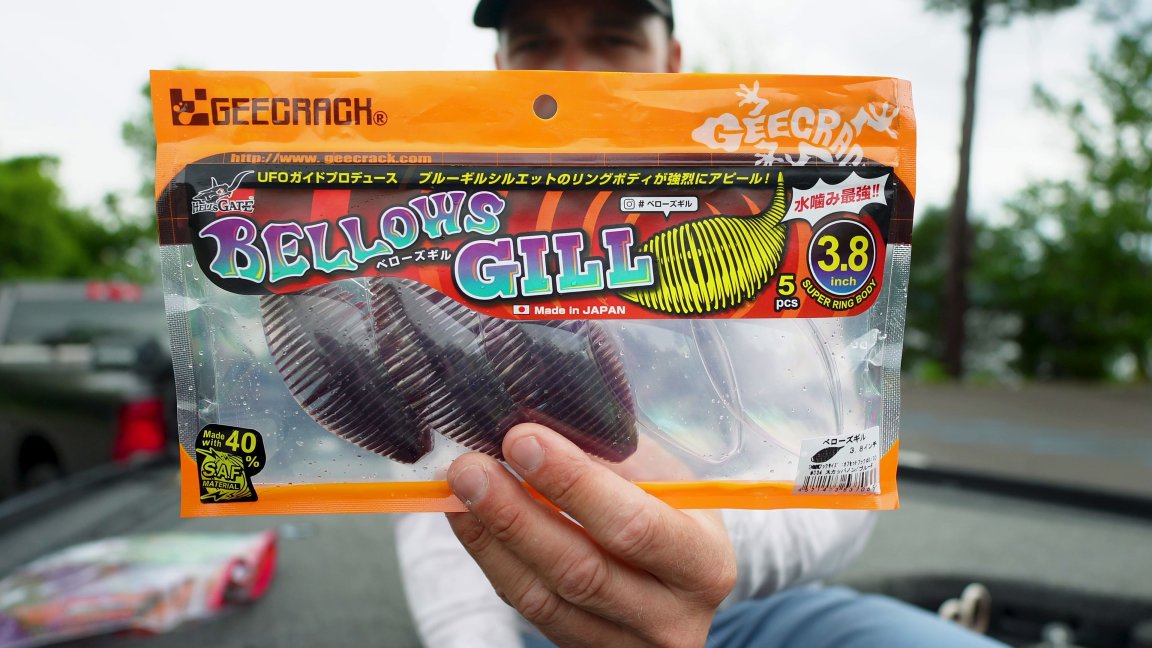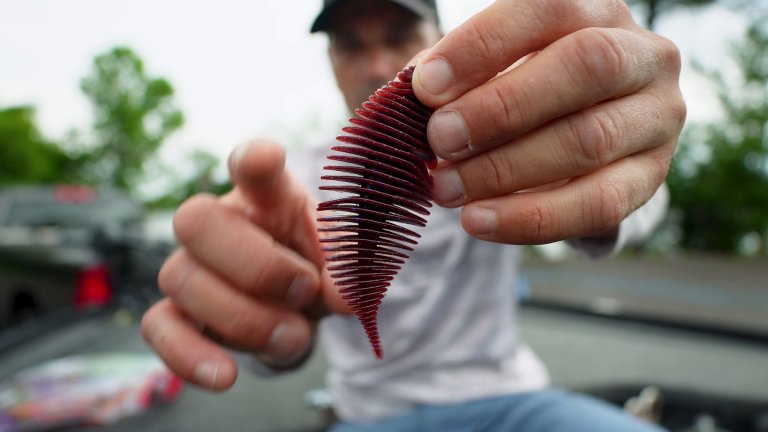We may earn revenue from the products available on this page and participate in affiliate programs. Learn More ›
It’s rare to see a truly innovative lure introduced into the bass fishing space, but such is the case with the Geecrack Bellows Gill. Though this Japanese Domestic Market (JDM) lure has been out for a few years now — and is a popular pick among anglers in the know — it’s flown relatively under the radar. That is, until recently.
As of late, this bait is gaining some traction here in the States. But its odd construction undoubtedly has a sizable number of bass anglers still asking, “What is this thing good for?” and “How would I even rig it?”
Well, those are the exact questions we’re here to help you with today. To better understand the Bellows Gill myself, I leaned on the expertise of bass fishing stud Mike Meisenheimer better known as Mikey Balzz. He’s been tinkering with this bait this summer, and his recent YouTube video on the lure actually sparked our interest in doing a piece about it. Here’s what Meisenheimer had to say about why he thinks the Geecrack Bellows Gill is so special, and how to use it.
Understanding the Geecrack Bellows Gill
The Bellows Gill has a body shaped like a flattened football. There’s a pin tail on one end and a stubbed nose on the other, with a spine connecting the two. Thin ribs span the bait from nose to tail, and the ribs vary gradually in thickness and width as you move along the bait.
The Bellows Gill comes in 31 color choices as well as four sizes: 2-inch, 2.8-inch, 3.8-inch, and 5.8-inch. Retailing for $9.49 per pack, you get 7, 6, 5 and 3 per pack respectively.
How to Rig the Bellows Gill

The Bellows Gill is as versatile as it is unique. You can fish it on a belly-weighted swimbait hook if you’d like or you can rig it up on a Carolina rig. You could also slide one on the back of a jig or chatterbait as a trailer, or use one on a skirtless buzzbait, pair it with a swing head or Tokyo rig, and even slip the 2-inch version on a Ned rig. The options are endless.
However the simplest way to rig the Bellows Gill is on a Texas rig. Here’s how.
Step 1: Select your bullet weight size. Something around 1/4-ounce will allow for more of a horizontal glide on the fall. Heavier weights will generate a more vertical fall.
Step 2: Select your hook. An EWG is the best bet, since this bait has a lot of plastic to it. The extra wide gap provides more bite and generates a better hookup than traditional worm hooks with round bends.
Step 3: Run your line through the bullet weight, then tie on the hook using your knot of choice.
Step 4: Orient the bait so that it lays flat and then run the hook point into the nose of the bait about a half inch and out the bottom. Slide the nose of the bait up onto the bend of the hook.
Step 5: Run the hook point back through the bottom of the bait and out of its back. Then skin the point of the hook back into the top of the bait.
What Makes the Bellows Gill so Effective

“It’s a totally different profile,” says Meisenheimer. “The ribs really give it this interesting movement, even in your hand. You’ll be amazed at how pliable it is when you take it out of the package. It’s a very soft and delicate bait. It really jiggles and moves with very little force imparted on it.”
When trying to find other baits to compare the Bellows Gill too, Meisenheimer landed on a cross between a Roboworm Zipper Worm and a Reaction Innovations 5.20 Beaver.
“It’s like a magnum oval-esque Zipper Worm from like the mid-90s out of California,” he says. “It has that very soft kind of Roboworm poured plastic to it. And it’s like flipping a 5.20 Beaver. It’s got a glide and you don’t need that much weight. You can just flip it out there and it does its little glide, jiggle thing.”
Meisenheimer credits the action and effectiveness of this bait not only to the profile of it, but also to the material used to make it.
“The ribs are very thin which adds to that action. They tear up pretty easily. But I think that’s part of the reason they have such good movement.”
Meisenheimer also brought to my attention the Floating Elastomer version of the Geecrack Bellows Gill. This version of the bait has the same profile but is made of a super buoyant material. This makes the bait even more versatile and better suited for a Carolina rig, drop shot, and free rig. The Floating Elastomer version comes in a handful of colors and one size (2.8 inches).
Final Thoughts on the Geecrack Bellows Gill

There’s a lot you can do with the Bellows Gill. If you’re going to rig the bait weedless on a Texas rig, Carolina rig, Tokyo rig or swing head, you’ll want to use either an EWG hook or at least a straight shank one. These hooks are better suited to accommodate the extra plastic this lure brings to the table. You can also rig the bait with the hook point exposed on jigs, Ned rigs, chatterbaits and other baits.
In any case, keep in mind that a lighter weight will allow the bait to do more. The heavier the weight, the more vertical the fall. But the beauty of this bait is in its glide and more intricate movements — from the undulation of the body to the wave of its ribs to the wag of its little tail. All of these finer aspects of the bait will have a better effect while working the bait slower, with lighter weight. So keep it light with your weights and let the Geecrack Bellows Gill really shine.

